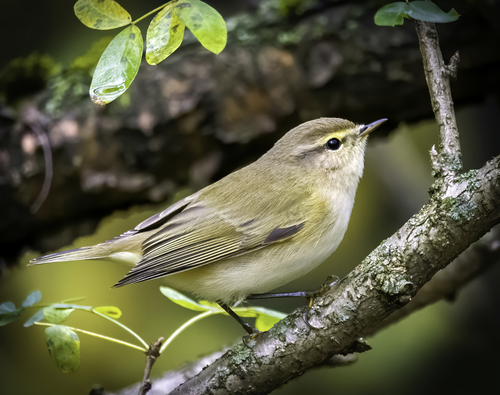
Common Chiffchaff
The Common Chiffchaff (*Phylloscopus collybita*) is a small, active leaf warbler widespread across Europe and Asia. It plays a crucial role in controlling insect populations, particularly in woodland and scrub habitats. This seemingly unremarkable bird is best known for its distinctive, repetitive 'chiff-chaff' song, which gives it its common name. While not culturally significant in the same way as some larger or more colorful birds, the Chiffchaff's arrival is often considered a harbinger of spring in many parts of Europe.
10-12 cm
Length
15-21 cm
Wingspan
Least Concern
Conservation Status
Distribution
Breeds across Europe and temperate Asia, extending east to eastern Siberia. Winters in southern and western Europe, the Mediterranean region, and parts of Africa and the Middle East. Migratory, with northern populations undertaking long-distance migrations.
Lifespan
Typically 2-3 years in the wild, but can live longer.
Common Chiffchaff's Habitat
Habitat Types
Open woodlands, Scrubland, Parks and gardens, Hedgerows, Forest edges
Climate Zones
Temperate, Boreal
Adaptations
Generally prefers habitats with a mix of trees and undergrowth, providing cover for foraging and nesting. Their small size and agility allow them to maneuver through dense vegetation.
Variations
Several subspecies are recognized, differing slightly in plumage coloration and song. For example, *P. c. tristis* (Siberian Chiffchaff) is generally greyer and has a different song.
Appearance
Breeding Plumage
Generally similar throughout the year.
Seasonal Feather Changes
Fresh plumage after molting in late summer can appear brighter, with slightly more yellowish tones.
Sex Based Plumage Differences
Males and females are visually very similar.
Notable Features
Olive-brown upperparts, Pale yellowish-white underparts, Short, pale supercilium (eyebrow stripe), Dark legs (distinguishing it from the Willow Warbler)
Diet and Feeding
Primary Foods
Small insects, Spiders, Larvae, Small invertebrates
Foraging Behavior
Actively gleans insects from leaves and branches, often hovering briefly to pick off prey. Will also flycatch, taking insects in mid-air.
Specializations
No specific physical specializations, but their agility and small size are well-suited to foraging in dense vegetation.
Seasonal Diet Variations
May consume some berries and fruits in autumn and winter when insect availability is lower.
Behavior
Social Structure
Generally solitary or in pairs during the breeding season. May form small, loose flocks during migration and in winter.
Communication
Distinctive 'chiff-chaff' song, Various call notes, including a 'hweet' contact call
Migration
Northern populations are strongly migratory, traveling south for the winter. Some southern populations are resident or only partially migratory.
Territorial or Group Behaviors
Males are territorial during the breeding season, defending their nesting area through song and aggressive displays.
Conservation
Threats
Habitat loss and degradation, Climate change (affecting migration timing and food availability), Pesticide use (reducing insect prey)
Protection Programs
General habitat protection measures, Monitoring programs to track population trends
Local National Laws
Protected under various national and international wildlife legislation, such as the EU Birds Directive.
Population Trend
Stable
Population Estimates
Estimated global population of 60,000,000 - 150,000,000 individuals.
Interesting Facts
The Chiffchaff's song is one of the earliest bird songs heard in spring in many parts of Europe.
This makes it a welcome sign of the changing seasons.
They are often confused with Willow Warblers, which are very similar in appearance.
However, Chiffchaffs typically have darker legs and a distinctly different song.
Chiffchaff can raise two broods in a single breeding season.
If conditions are favorable.
Faqs about Common Chiffchaff
What is the difference between a Chiffchaff and a Willow Warbler?
The easiest way to tell them apart is by their song. Chiffchaffs have a repetitive 'chiff-chaff' song, while Willow Warblers have a more melodic, descending song. Chiffchaffs also tend to have darker legs.
Where do Chiffchaffs migrate to?
Northern populations migrate to southern Europe, the Mediterranean region, and parts of Africa and the Middle East for the winter.
What do Chiffchaffs eat?
They primarily eat small insects and spiders, but may also consume some berries and fruits in autumn and winter.
Copyright @ Nature Style Limited. All Rights Reserved.
 English
English